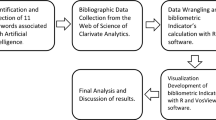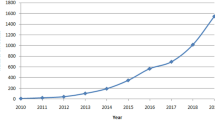Abstract
The Applied Intelligence (APIN) published its first issue in 1991 and it is one of the important academic journals in the field of computer science. This study aims to examine the structure and citation landscape as well as the evolution of the APIN journal based on all the APIN articles included in web of science core collection database. Research results of this study including the author characteristics, manuscript characteristics, productive and influential institutions and countries. Various kinds of networks are provided to visualize the complex relationships from different perspectives, including institutions and countries. The co-occurrence network and detection of the bursting keywords are used to explore the research hotspots in the APIN journal. The main advantage of this study is that it provides a comprehensive and objective view of the APIN journal. This study is very helpful for scholars to grasp the content structure and development process of APIN journal. It is also valuable for scholars in the field of artificial intelligence to identify the research hotspots in this field.




Similar content being viewed by others
References
Aha DW, Breslow LA, Muñoz-Avila H (2001) Conversational case-based reasoning. Appl Intell 14(1):9–32
Bornmann L, Daniel HD (2007) What do we know about the h index? J Am Soc Inf Sci Technol 58 (9):1381–1385
Bornmann L, Mutz R (2015) Growth rates of modern science: a bibliometric analysis based on the number of publications and cited references. J Assoc Inf Sci Technol 66(11):2215–2222
Boyack KW, Klavans R (2010) Co-citation analysis, bibliographic coupling, and direct citation: which citation approach represents the research front most accurately? J Am Soc Inf Sci Technol 61(12):2389–2404
Brest J, Maučec MS (2008) Population size reduction for the differential evolution algorithm. Appl Intell 29(3):228–247
Burke E, Cowling P, De Causmaecker P, Berghe GV (2001) A memetic approach to the nurse rostering problem. Appl Intell 15(3):199–214
Calma A, Davies M (2015) Studies in higher education 1976–2013: a retrospective using citation network analysis. Stud High Educ 40(1):4–21
Calma A, Davies M (2016) Academy of management journal, 1958–2014: a citation analysis. Scientometrics 108(2):959–975
Chan KC, Chang CH, Lo YL (2009) A retrospective evaluation of European financial management (1995–2008). Europ Financ Manag 15(3):676–691
Chen C, Song IY, Yuan X, Zhang J (2008) The thematic and citation landscape of data and knowledge engineering (1985–2007). Data Knowl Eng 67(2):234–259
Chen MY, Jenkins CB, Elster AD (2003) Internationalization of the American journal of roentgenology: 1980–2002. Amer J Roentgenol 181(4):907–912
Chen SJ, Chen SM (2007) Fuzzy risk analysis based on the ranking of generalized trapezoidal fuzzy numbers. Appl Intell 26(1):1–11
Cronin B, Meho L (2006) Using the h-index to rank influential information scientists. J Am Soc Inf Sci Technol 57(9):1275–1278
Deng Y (2015) Generalized evidence theory. Appl Intell 43(3):530–543
Diederich J, Kindermann J, Leopold E, Paass G (2003) Authorship attribution with support vector machines. Appl Intell 19(1-2):109–123
Dubois D, Fargier H, Prade H (1996) Possibility theory in constraint satisfaction problems: handling priority, preference and uncertainty. Appl Intell 6(4):287–309
Eito-Brun R, Rodríguez ML (2016) 50 years of space research in Europe: a bibliometric profile of the European Space Agency (ESA). Scientometrics 109(1):551–576
Feng Y, Zhu Q, Lai KH (2017) Corporate social responsibility for supply chain management: a literature review and bibliometric analysis. J Clean Prod 158:296–307
Ferreira FA (2018) Mapping the field of arts-based management: bibliographic coupling and co-citation analyses. J Bus Res 85:348–357
Foy JP, Bertolus C, Goudot P, Deneuve S, Blanc E, Lasset C, Saintigny P (2018) Bibliometric analysis of a century of research on oral erythroplakia and leukoplakia. J Oral Pathol Med 47(4):388–395
García-Lillo F, Úbeda-García M, Marco-Lajara B (2016) The intellectual structure of research in hospitality management: a literature review using bibliometric methods of the journal International. J Hospital Manag Int J Hospit Manag 52:121–130
Ji L, Liu C, Huang L, Huang G (2018) The evolution of resources conservation and recycling over the past 30 years: a bibliometric overview. Resour Conserv Recycl 134:34–43
Kim MC, Chen C (2015) A scientometric review of emerging trends and new developments in recommendation systems. Scientometrics 104(1):239–263
Kessler MM (1963) Bibliographic coupling between scientific papers. Amer Documen 14(1):10–25
He XR, Wu YY, Yu DJ, Merigó JM (2017) Exploring the ordered weighted averaging operator knowledge domain: a bibliometric analysis. Int J Intell Syst 32(11):1151–1166
Hirsch JE (2005) An index to quantify an individual’s scientific research output. Proc Natl Acad Sci 102 (46):16569–16572
Hirsch JE (2007) Does the h index have predictive power?. Proc Natl Acad Sci 104(49):19193–19198
Kononenko I, Šimec E, Robnik-Šikonja M (1997) Overcoming the myopia of inductive learning algorithms with RELIEFF. Appl Intell 7(1):39–55
Laengle S, Merigó JM, Miranda J, Sowiński R, Bomze I, Borgonovo E, Teunter R (2017) Forty years of the European journal of operational research: a bibliometric overview. Eur J Oper Res 262(3):803–816
Laengle S, Modak NM, Merigo JM, Zurita G (2018) Twenty-five years of group decision and negotiation: a bibliometric overview. Group Decis Negot 27(4):505–542
Li X, Wu P, Shen GQ, Wang X, Teng Y (2017) Mapping the knowledge domains of building information modeling (BIM): a bibliometric approach. Autom Constr 84:195–206
Liu RL (2017) A new bibliographic coupling measure with descriptive capability. Scientometrics 110(2):915–935
Martínez-López FJ, Merigó JM, Valenzuela-Fernández L, Nicolás C (2018) Fifty years of the European J Market bibliometric analysis. European J Market 52(1/2):439–468
Mazov NA, Gureev VN (2017) Bibliometric analysis of the flow of publications by Novosibirsk State University in collaboration with the RAS Siberian Branch. Her Russ Acad Sci 87(5):445–453
Merigó JM, Blanco–Mesa F, Gil–Lafuente AM, Yager RR (2017) Thirty years of the international journal of intelligent systems: a bibliometric review international. J Intell Syst 32(5):526–554
Merigó JM, Mas-Tur A, Roig-Tierno N, Ribeiro-Soriano D (2015) A bibliometric overview of the journal of business research between 1973 and 2014. J Business Res 68(12):2645–2653
Merigó JM, Pedrycz W, Weber R, De la Sotta C (2018) Fifty years of information sciences: a bibliometric overview. Inform Sci 432:245–268
Merigó JM, Yang JB (2017) A bibliometric analysis of operations research and management science. Omega 73:37–48
Nagarajan R, Teixeira AA, Silva S (2017) The impact of population ageing on economic growth: a bibliometric survey. Singapore Econ Rev 62(2):275–296
Nederhof AJ (2006) Bibliometric monitoring of research performance in the social sciences and the humanities: a review. Scientometrics 66(1):81–100
Ombuki B, Ross BJ, Hanshar F (2006) Multi-objective genetic algorithms for vehicle routing problem with time windows. Appl Intell 24(1):17–30
Paschen J, Wilson M, Nehajowich J, Prpić J (2016) Fine wine through time: a review of the. J Wine Res J Wine Res 27(2):91–104
Qasim M (2017) Sustainability and wellbeing: a scientometric and bibliometric review of the literature. J Econ Surv 31(4):1035–1061
Schaal S, Atkeson CG, Vijayakumar S (2002) Scalable techniques from nonparametric statistics for real time robot learning. Appl Intell 17(1):49–60
Şenel E, Demir E (2018) Bibliometric and scientometric analysis of the articles published in the journal of religion and health between 1975 and 2016. J Relig Health 57(4):1473–1482
Shekhani HN, Shariff S, Bhulani N, Khosa F, Hanna TN (2017) Bibliometric analysis of manuscript characteristics that influence citations: a comparison of six major radiology journals. Am J Roentgenol 209(6):1191–1196
Tal D, Gordon A (2018) Women as political leaders: a bibliometric analysis of the literature. Society 55(3):256–261
Tur-Porcar A, Mas-Tur A, Merigó JM, Roig-Tierno N, Watt J (2018) A bibliometric history of the journal of psychology between 1936 and 2015. J Psychol 152(4):199–225
Van Fleet DD, Ray DF, Bedeian AG, Downey HK, Hunt JG, Griffin RW, Feldman DC (2006) The journal of management’s first 30 years. J Manag 32(4):477–506
Wang WR, Laengle S, Merigó JM, Yu DJ, Herrera-Viedma E, Cobo MJ, Bouchon-Meunier B (2018) A bibliometric analysis of the first twenty-five years of the international journal of uncertainty, fuzziness and knowledge-based systems. Int J Uncert Fuzziness Knowl-Based Syst 26(02):169–193
Yu DJ (2015) A scientometrics review on aggregation operator research. Scientometrics 105(1):115–133
Yu DJ, Xu C (2017) Mapping research on carbon emissions trading: a co-citation analysis. Renew Sustain Energy Rev 74:1314–1322
Yu DJ, Xu ZS, Pedrycz W, Wang WR (2017) Information sciences 1968–2016: a retrospective analysis with text mining and bibliometric. Inf Sci 418:619–634
Yu DJ, Xu ZS, Wang WR (2018) Bibliometric analysis of fuzzy theory research in China: A 30-year perspective. Knowl-Based Syst 141:188–199
Yu DJ, Xu ZS, Kao Y, Lin CT (2018) The structure and citation landscape of IEEE transactions on fuzzy systems (1994–2015). IEEE Trans Fuzzy Syst 26(2):430–442
Zhang Y, Chen H, Lu J, Zhang G (2017) Detecting and predicting the topic change of knowledge-based systems: a topic-based bibliometric analysis from 1991 to 2016. Knowl-Based Syst 133:255–268
Acknowledgements
This work was supported by the project of philosophy and Social Science in Zhejiang (No. 16NDJC159YB), the China National Natural Science Foundation (Nos. 71771155, 71571123), the Zhejiang Science & Technology Plan of China (No. 2015C33024), and the Zhejiang Provincial Natural Science Foundation of China (No. LY17G010007).
Author information
Authors and Affiliations
Corresponding author
Rights and permissions
About this article
Cite this article
Yu, D., Xu, Z. & Fujita, H. Bibliometric analysis on the evolution of applied intelligence. Appl Intell 49, 449–462 (2019). https://doi.org/10.1007/s10489-018-1278-z
Published:
Issue Date:
DOI: https://doi.org/10.1007/s10489-018-1278-z




